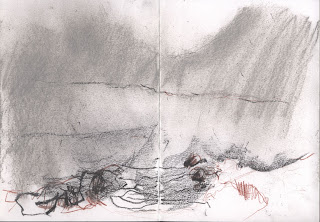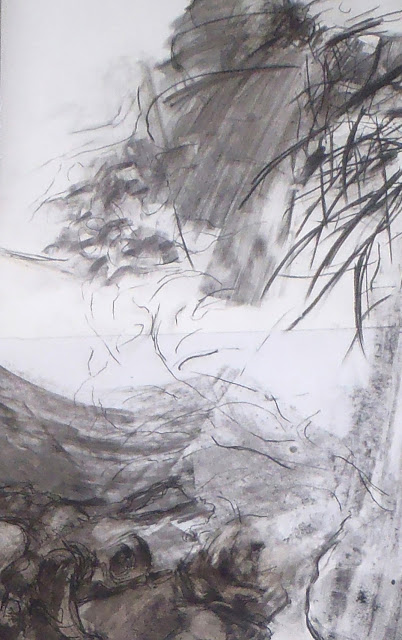Crossing the fine grained sands of a particular Welsh beach, I noticed how the motion of walking is generating an unusual sound. I am wearing thick soled boots, the movement of the fine sand is causing a clear whistle via the two independent substances and activity.
Many years ago I read:
Joseph Beuys thinks from his knees, his relationship to art was inseparable from his body which he represented through many differing substances, animal and mineral.
In How to explain paintings to a dead hare 1965, Beuys connected a childhood attraction; the presence of something that nobody noticed, together with an intuition of his own history and time. (Art Forum Summer 1991 p.85)
How to explain paintings to a dead hare 1965
(image found in Gardeners Art History Review)
A moment of pure happenstance
It was exactly this same year my family rescued and nurtured an orphaned hare after seeing his mother killed. Beuys' art is influenced by being rescued and bought back to life by nomadic tribesmen.
Dad and me and Sammy the rescued hare 1965
I walk, I look and occasionally find something unnoticed.
I work from my feet, connecting sounds, motion, terrain. I think through drawing as I focus on an unknown particularity. The act of drawing takes me elsewhere, each individual encounter continues to impact on memory.
‘When you give yourself to places, they give you yourself back’.
Rebecca Solnit in Wanderlust. 2002. London, Verso- p.13
A continually changing viewpoint cannot be understood by standing still.
Snowdonia long drawing 14 Graphite, charcoal, chalk, carbon pencil Jill Evans 2013
I move a viewer beyond the role of motionless observer in
Snowdonia long drawing, continuing the process of its making and exploring the role of drawing as a residual object; it is necessary for a viewer to walk to view.
Here its form is dictated by the process of making but its reality is elsewhere in the mind of the observer.
Each viewer has absorbed and carries with them the multitude of differences of place or situation and frequently encounters these through unconscious reflection, they reveal a link to specific place.
In Snowdonia long drawing the constructed table reflects back into history, culture and place, through the materials used and its presence.
Like a good story endlessly retold, changing and gradually developing, I expect this blog and my drawing to continue on beyond the MA.







